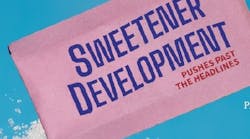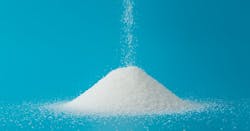Ever since a single study in the 1970s linked saccharin to cancer, there has been a steady flow of research connecting one or more health concerns to nearly every synthetic sweetener to come on the market. Sucralose took it on the chin this past May. In July, it was aspartame getting the black eye.
Interestingly, the company behind Splenda sucralose last month slapped a defamation suit on the North Carolina State University scientist who headed the research that started the sucralose flap. TC Heartland LLC said her claims about the non-nutritive sweetener's alleged cancer-causing compounds are false, caused a media frenzy and needlessly scared customers.
Despite all that, interest remains high in sugar replacements -- in part because the price of sugar itself hit an all-time high in June of this year. While the price has retreated a bit since, it’s still unusually high, and there are fears of shortages because of weather events in sugar-growing areas.
"In the confectionery arena, heightened health-conscious demand converges with supply constraints, providing confectionery manufacturers with the opportunity to embark on reduced sugar initiatives,” says Nancy Hughes, president of sweetener supplier Apura Ingredients (www.apuraingredients.com). “Stevia and monk fruit extract alongside allulose assume starring roles, synergizing taste enhancement, texture refinement and functional properties to create ‘sweets’ that align with consumer preferences."
Product developers’ search for the perfect sugar substitute goes on, and many were on display at this year’s Institute of Food Technologists’ IFT FIRST expo in July; some of those are mentioned below. There also was an emerging theme among some of the sweetener suppliers of providing not just sweetness but also taste modification – don’t miss that part at the end.
Allulose
Allulose has been gaining in popularity with product developers – and even with consumers – since 2019 when the FDA declared the monosaccharide isomer of fructose could be excluded from the total sugar on nutrition panels because it contains virtually no calories.
It’s known as a "rare sugar" because it's found in small amounts in maple syrup, brown and caramel sauces, and fruits like raisins and figs. It delivers 70% of the sweetness of sucrose with less than 10% of the calories.
A 2023 research study compared the glycemic and insulin response to allulose and its potential ability to blunt postprandial glucose when consumed with a carbohydrate-containing meal. The results, publicized by Anderson Advanced Ingredients (www.advancedingredients.com), a supplier of allSweet, indicate allulose suppresses glucose and insulin responses on its own and mitigates the response when consumed with sucrose.
Allulose was a key ingredient in many of the samples in the IFT booth of Ingredion (www.ingredion.com). Astraea allulose was developed by Matsutani, but the Japanese company and Ingredion formed a partnership and in 2019 built a plant in Mexico to manufacture this ingredient for the Americas. The company says it not only tastes like sugar but acts like sugar in formulations, contributing bulking, browning and freeze-point depression properties as well as sweetness.
Allulose is just one of the sweeteners in the Ingredion portfolio. The 2020 acquisition of PureCircle brought a range of stevia products and rebaudiosides, with a lot of current focus on reb-M. Ingredion also offers Versasweet low-sugar corn- or tapioca-based glucose syrups, which are a third as sweet as sucrose and have a 50-70% lower percentage of mono- and disaccharides compared to traditional glucose syrups.
Although its IFT show efforts focused on Orafti B-Fit, a whole-grain barley flour rich in beta glucans, Beneo (beneo.com) long has offered Palatinose, an isomaltulose based on sugar beet sucrose. It’s generated through enzymatic rearrangement of the glycosidic bond between glucose and fructose, yielding a molecule more stable than sucrose with half the sweetness and no aftertaste.
Tagatose
ASR Group (www.asr-group.com) is best known for its sugar brands: Domino, Florida Crystals, C&H. But at this year’s IFT show, its spotlight was on tagatose. Like allulose, it’s a rare sugar and is only partially metabolized. It’s about 90% as sweet as sucrose with about 40% of the calories.
It does not raise blood sugar levels – it has a glycemic index of 3 -- nor promote tooth decay and exhibits some prebiotic effects.
ASR is among the investors (Hershey is another) that helped fund development of tagatose and construction of a production facility by Bonumose. Founded in 2016 and still an early-stage food ingredient manufacturer, Bonumose developed and patented enzymatic processes for continuous production of high-purity tagatose, allulose and other ingredients. Bonumose opened an R&D facility and manufacturing plant earlier this year in Charlottesville, Va., and at mid-year got a minority investment from German ingredients company Symrise.
Stevia still has its fans
Sweegen (sweegen.com) at IFT had a changing menu of samples highlighting its Bestevia sweeteners, featuring stevia rebaudisides B, D, E, I, M and N, “along with our deep knowledge of flavor modulators and texturants.” From the pineapple chili sauce in Monday’s California tacos to the reduced-sugar barbecue sauce in Wednesday’s BBQ chicken slider, even savory applications can be sweetened with Bestevia products.
If that list sounds like the alphabet, it’s because there are more than 200 species of stevia rebaudiosides, according to Apura’s Hughes. “The most common forms are stevioside and rebaudioside A (reb-A). The portfolio expands from there with different materials, derivatives, extracts, grades and blends.”
While stevia originally was steeped like tea from the leaves, biofermentation is becoming the preferred method of producing stevia. “Bio fermentation … can offer a more efficient and consistent way to produce specific steviol glycosides, including ones present in trace amounts or challenging to extract from the plant itself,” explains Hughes. Apura Ingredients recently launched Stevia Bio Converted Reb M, manufactured in the U.S.
Tate & Lyle (www.tateandlyle.com) used IFT FIRST to reveal a new addition to its sweetener portfolio with an emphasis on solubility. Tasteva Sol Stevia Sweetener is the result of an “internationally patent-protected breakthrough in stevia technology”; it’s made by an enzymatic process from stevia leaf extract.
Tasteva Sol is more than 200 times more soluble than the reb-M and -D products on the market, according to the company, thereby solving for solubility challenges often found in beverage concentrates, dairy fruit preparations and sweet syrups at high sugar replacement levels. It can be used alone or in combination with reb-M stevia sweeteners for high sugar replacement.
Carob
Carob is probably best known as a substitute for chocolate because of its color, texture and taste … and its sweetness. Carob pods are mildly sweet, roughly one-third to one-half sugar by dry weight.
“It’s been known for years to provide sweetness to cooking, especially around the Mediterranean, but never as a sweetener ingredient,” Udi Alroy, founder and CEO of Carobway (carobway.com), said from his stand in IFT’s area for startup companies.
Carobway, an Israeli company, transformed carob fruit into a sweetener with 92% dextrose equivalent. Alroy says it has a “caramelly-fudgey” sweetness and evokes a slower glycemic response than sucrose. Applications would be bars, cookies gummies, beverages and granola. It also contributes a fair amount of fiber and works as a prebiotic.
Carobway has developed it as a syrup and is working on a powder form. Commercial quantities aren’t available yet but should be by 2025; samples for R&D work are available.
Reduced-calorie syrups
Distributor Ciranda (www.ciranda.com) showed three new syrups capable of sweetening. Tapioca Syrup RS18 is a clear, mildly viscous syrup produced from tapioca starch. Its sweetness is similar to Ciranda’s tapioca syrup DE40, but with 38% less sugar. RS18 has film-forming and binding properties typically found in lower DE syrups. This makes it an effective single-syrup solution in bars, confections and gummy supplements.
Organic Agave Syrup AL40 is a sweet, light amber syrup produced from the blue agave plant. A portion of the fructose is converted into allulose, resulting in a sweet syrup with 40% less sugar and 40% fewer calories than Ciranda’s standard agave syrup. AL40 can be used to create better labels in frozen desserts, beverages and cereals.
Organic Agave Syrup IN10 is similar, but with 9% less sugar and 8% fewer calories than Ciranda’s standard organic agave syrup, with 10% of the solids retained as prebiotic inulin fiber. It can help achieve cleaner labels in functional food and beverage applications. All of these syrups are Non-GMO Project Verified.
Enhancing the perception of sweetness
Allulose may be the key ingredient in SilkySweet (www.silkysweet.com) from Silky Smooth MicroCreamery, but one of the product’s major claims is that it also enhances the perception of sweetness. SilkySweet mixes non-bioengineered allulose with monk fruit and a proprietary sweetener that matches the profile of stevia to deliver the sweetness, but the product actually has nine ingredients, including bitterness maskers, flavor modulators, flavor enhancers “and a pinch of sea salt” to enhance the improve overall flavor of whatever it’s in.
Apura has a catalog that covers just about every non-nutritive sweetener on the market. But much of its focus at IFT was showing off PuraSweet SCR3025, a proprietary natural sweetness enhancer. It replicates the action of sucrose on taste receptors and delivers the required upfront and middle sweet flavors with a pleasant ending. It’s thermally stable, has an extended shelf life and is available in powder and liquid formats; it’s labeled as “natural flavor” on product labels.
“Developed in response to cost and supply concerns over corn-based sweeteners, PuraSweet enables CPG manufacturers to reduce sugar and calories by 30% while achieving up to 25% cost savings in sugar spend,” the company says. “This flavor has also shown success in replacing high-fructose corn syrup.”
Sweegen also played to taste modulation by promoting its sweet proteins, primarily Brazzein. They “hit a different receptor that other non-caloric sweeteners do not,” the company says. ‘This enables a higher quality of sweetness and also amplifies flavor expression creating a more sugar-like taste experience.”




